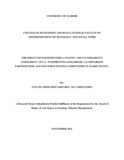The impact of participatory capacity and vulnerability assessment ( PCVA) in improving livelihood: Acomparison participating and non-participating communities in Wajir county.
Abstract
Wajir County is one of the arid and semi arid counties in Kenya that has been experiencing the
negative effects of recurrent drought throughout. Oxfam GB an international Non
Governmental Organization (NGO) has been implementing a Community Managed Disaster
Risk Reduction Programme (CMDRR) by employing Participatory Capacity and Vulnerability
Assessment(PCVA). This approach uses various participatory tools to gauge people‘s exposure
to and capacity to resist natural hazards. The study sought to compare the impact of PCVA in
two villages. The purpose of the task was to examine whether there is a difference in livelihood
between those pastoralists who have participated in PCVA and those who have not. Specifically,
the study aimed at finding whether there is a difference in ownership of basic life sustaining
properties such as cattle, sheep, goats, and camel. It also aimed at finding out whether the
community members have realized any change in their lives in regard with food security,
economic growth and increase in animals since 2011 when PCVA was introduced. This
research was a comparative study comparing two villages (one with PCVA and one which had
not received this intervention).
The PCVA beneficiaries were asked to rate the interventions in terms of risk reduction
strategies, livelihood improvement strategies, and drought mitigation strategies. At the same
time the study sought to establish whether PCVA is a factor in livelihood improvement by doing
Chi-Square tests on animal ownership and level of satisfaction in economic growth, increase in
livestock and food security. On establishing whether PVCA had increase ownership of animals
the study revealed that the PVCA group had a higher number of animals as compared with the
group without PVCA. This could be attributed to the intervention meaning that mitigation
measures put in place by PVCA could be a factor in the high numbers of animals owned by the
PVCA group. Comparatively there is a high level of satisfaction on the economic growth,
livestock increase and food security among the PVCA participating group compared to the group
without PVCA.
Chi-Square test of Independence was used to test whether or not 1)There is an
association between PVCA and owning animals.2)There is an association between PVCA and
satisfaction on the development achieved so far. In the two tests the findings were that PVCA
is not associated the number of animals own in Wajir. Neither is the program associated with
the level of satisfaction expressed the people of Wajir over the development achieved so far.
Meaning that PVCA has made little if any impact on the livelihoods of the people of
Wajir.PCVA is not associated with the number of animals that people owned because
pastoralism has been the key agricultural production system in the dry lands and remains
dominant livelihood base of the people of Wajir (99%).The level of satisfaction expressed on the
changes achieved in terms on increase in animals, food security and economic growth is not
associated because PCVA might not be different than the previous approach used before and
the study recommended that sustainability, ownership and stakeholder involvement
diversification of livelihood and pro-pastoral policies and advocacy are crucial in the successful
implementation of this approach
Publisher
University of Nairobi

